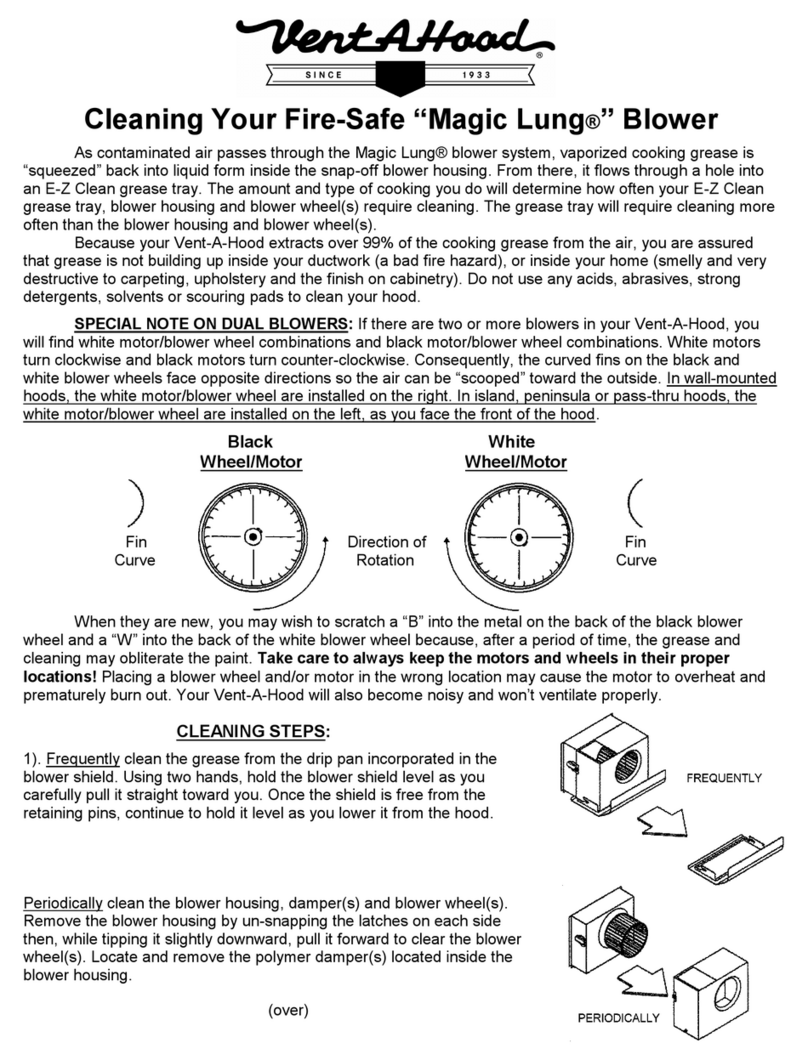
L101 0810A Page 1
24”
12 ¼”
20”
28”
24 ¾”
RM1500
CFM Ratings and Electrical Specications
Model CFM At Static Pressure Ps = Inches of Water Volts Amps Hz Duct
Size
0.0" Ps 0.1" Ps 0.2" Ps 0.3" Ps 0.5" Ps
RM1000 945 922 884 852 770 120 3.2 60 10"
RM1500 1500 1455 1410 1375 1295 120 5.0 60 10"
INSTALLATION INSTRUCTIONS
FOR REMOTE BLOWER MODEL RM1000 & RM1500
READ AND SAVE THESE INSTRUCTIONS
WARNING - TO REDUCE THE RISK OF FIRE, ELECTRIC SHOCK, OR INJURY TO PERSONS,
OBSERVE THE FOLLOWING:
A. Use this unit only in the manner intended by the manufacturer.
If you have questions, contact the manufacturer at the
address or telephone number listed on the back cover of
the Homeowner’s Manual.
B. Before servicing or cleaning unit, switch power off at the
service panel and lock the service disconnecting means to
prevent power from being switched on accidentally. Then
the service disconnecting means cannot be locked, securely
fasten a prominent warning device, such as a tag, to the
service panel.
C. Installation work and electrical wiring must be done by
qualied person(s) in accordance with all applicable codes
and standards, including re-rated construction codes and
standards.
D. Sufcient air is needed for proper combustion and exhausting
of gases through the ue (chimney) of fuel burning equipment
to prevent back drafting. Follow the heating equipment
manufacturer’s guideline and safety standards such as
those published by the National Fire Protection Association
(NFPA), and the American Society for Heating, Refrigeration,
and Air Conditioning Engineers (ASHRAE), and the local
code authorities.
E. When Cutting or drilling into wall or ceiling, do not damage
electrical wiring or other hidden utilities.
F. Ducted fans must always be vented to the outdoors.
WARNING
1. TO REDUCE THE RISK OF FIRE, USE ONLY METAL
DUCTWORK.
2. THIS FAN IS UL LISTED FOR USE WITH VENT-A-HOOD
MODEL B210R.
CAUTION
1. FOR GENERAL VENTILATION USE ONLY. DO NOT USE
TO EXHAUST HAZARDOUS OR EXPLOSIVE MATERIALS
AND VAPORS.
INSTALLATION TIPS
1. For best performance, keep duct length and number of
elbows to a minimum. 10” round ducting or equivalent is
recommended.
2. Select a location that is free of obstacles such as heating and
air conditioning ducts, water pipes, electrical wiring, etc.
3. Position discharge of the blower down towards ground level
and away from prevailing winds to minimize back drafts.
4. For best appearance, locate the fan on the rear of the house,
below the top of the roof line.
PRODUCT SPECIFICATIONS





















